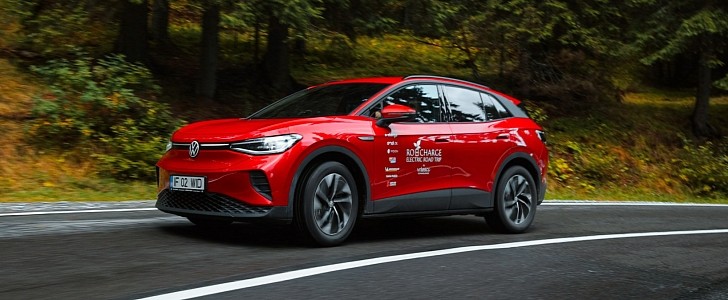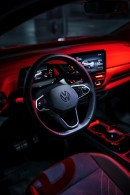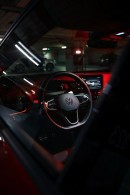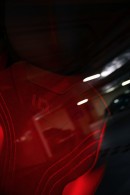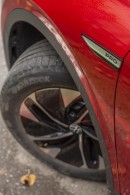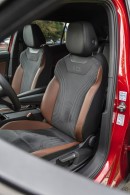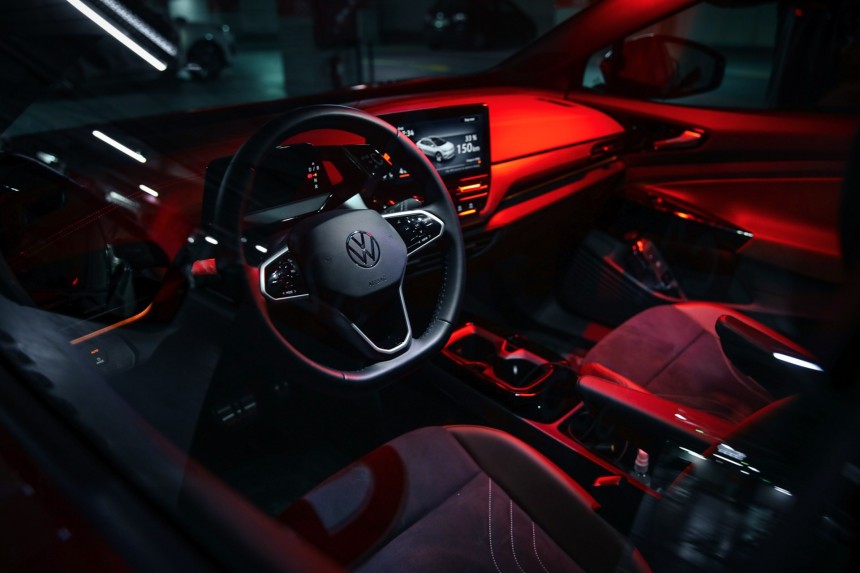Driven: 2021 Volkswagen ID.4, the First Electric Crossover From VW
Volkswagen's ID.4 is not the second EV from VW, but it is the second model of the ID range. It is a crossover built on the MEB platform, and it brings an SUV-shaped body to the ID.3's platform to offer more space and practicality. Some consider it to be the Tiguan of electric cars, but what does that mean?
Volkswagen's Tiguan is almost as good as its Golf if you think about practical aspects of a car, along with how easy it is to drive, its neutral and predictable handling, as well as its ergonomic controls. Its design is also a no-risk proposal from VW, so nobody should hate the car, just maybe not like it too much.
Is the ID.4 anything like what I described above? Well, it is supposed to be, but it is not entirely so. First, the design. It looks more distinguished when compared to a conventional VW, and you might say that it looks good.
It does have a few questionable decisions, such as the door handles that do not need to be moved to open the doors, but still move and give the impression that you might have broken them when operating them in a hurry.
The good news is that the VW ID.4 is predictable in handling and neutral in driving, as well as easy to drive. These aspects make it similar to the VW Golf and the Tiguan, which tend to be popular in Europe and many countries around the world.
The steering does not need too much effort to operate, and it does not exaggerate in feedback. It is just enough to figure out the basic things you need to know when driving, but not too much. The suspension is calibrated for comfort, but the body roll is minimal except if you attempt a slalom course.
Braking power is adequate, but most driving scenarios will have you using the regenerative braking system to slow the car down to a complete stop in most situations. That is our recommendation for the best possible range and using the full braking power just in emergencies.
However, things do not go that well when you consider the ergonomic side of things. Its interior has ditched as many buttons as possible, which makes it complicated to operate when compared to a conventional VW.
It is also more complicated than other electric vehicles in general. While it is meant to be simple and has all its controls on a single screen, with the digital gauge cluster meant to be just that, its control interface needs to be improved.
What is wrong with the interface? Well, you need to look at the screen to change relevant settings, like temperature or the current driving mode. The temperature and volume can be adjusted with the slide of a finger, but that happens on a piano-black surface that has no illumination (so you cannot see it while driving after dark) and there is no haptic feedback when operating. So, you still need to look at the screen in the middle of the dash.
It is worth noting that the interface on our test drive car was not exactly fast, and I previously test drove another example of an ID.4 that had the same issue.
A previous test with an ID.3 also showed issues with the interface, where the command for the electric louver of the panoramic roof would not work from the center screen, but it did work from a separate control placed on the roof.
But what is it like to drive? Well, the ID.4 does not bring a major surprise to the VW range when driving sensations are concerned. It is obviously configured to be comfortable, and that is easy to feel in terms of suspension and steering, while the acceleration is brisk until just above 100 kph (62 mph), but it gets slower from there.
VW offers the ID.4 Pro Performance with a 77-kWh battery that powers a 204 PS electric motor, which provides 310 Nm of torque. While delivered instantly, the figures compare to the ongoing 2.0 TSI engine, except for the lack of any noise, less torque, and a different delivery style.
The electric motor is set up to offer a linear experience, like a well-adjusted naturally aspirated engine, though one with a lot of torque down low in the rev range.
Regenerative braking is not adjustable with paddles on the steering wheel, but you can select the B mode from the gauge-cluster-mounted gear selector. The latter feels just like the one on the BMW i3, but it is not identical.
Top speed is limited to 160 kph (99 mph), while 0-100 kph (62 mph) happens in 8.5 seconds. It is not the fastest car on the road, and it is not meant to be. Instead, the VW ID.4 will be able to easily pass other vehicles that are driving at a reasonable speed, but not leave them as dots in the rearview mirror.
It is not meant for the racetrack. Instead, it is meant for daily driving, a task that it can do with ease due to its high range, estimated at 522 km (324 miles) in the WLTP cycle.
Yes, the ID.4 can drive a long distance with a single charge, despite its larger and higher body when compared to an ID.3. Volkswagen managed to make an electric vehicle with a range that is very good, but stopped short of getting the car to be ergonomically optimal on the interior in an attempt to offer a futuristic feeling. That part was the big disappointment with the ID.4 for me.
The ID.4 might have been better with conventional controls for the climate system, as well as conventional buttons on the steering wheel instead of capacitive ones.
It may be great if you want to feel like you bought a car from the future or impress your Tesla-owning friends, but it is not intuitive to use, nor does it get easier, as you will need to take your eyes away from the road to adjust any function of the climate system.
We started our drive in the VW ID.4 with a fully charged battery and drove 139 kilometers (86 miles). The battery had 61 percent charge left, and the car had a consumption of 20.0 kWh/100 km (62 miles) with an average speed of 46 kph (28.5 mph). We could have driven another 248 kilometers (154 miles) that day with the energy left in the battery, according to the ID.4's computer.
We charged the battery up to 66 percent, and the vehicle was then driven 223 kilometers (138 miles) the next day, and it still had 14 percent left in its battery after the drive, which happened at an average speed of 45 kph (27.9 mph), but with lower average energy consumption, of just 15.8 kWh/100 km (62 miles).
So, does Volkswagen have a winner in its hands? VW says this is part of its electric revolution, and the ID.4 feels like a better car than the ID.3 if you ask me. It gets to be just a bit more practical in day-to-day life and have more room inside, while also having a generous range.
Is the ID.4 anything like what I described above? Well, it is supposed to be, but it is not entirely so. First, the design. It looks more distinguished when compared to a conventional VW, and you might say that it looks good.
It does have a few questionable decisions, such as the door handles that do not need to be moved to open the doors, but still move and give the impression that you might have broken them when operating them in a hurry.
The good news is that the VW ID.4 is predictable in handling and neutral in driving, as well as easy to drive. These aspects make it similar to the VW Golf and the Tiguan, which tend to be popular in Europe and many countries around the world.
The steering does not need too much effort to operate, and it does not exaggerate in feedback. It is just enough to figure out the basic things you need to know when driving, but not too much. The suspension is calibrated for comfort, but the body roll is minimal except if you attempt a slalom course.
Braking power is adequate, but most driving scenarios will have you using the regenerative braking system to slow the car down to a complete stop in most situations. That is our recommendation for the best possible range and using the full braking power just in emergencies.
However, things do not go that well when you consider the ergonomic side of things. Its interior has ditched as many buttons as possible, which makes it complicated to operate when compared to a conventional VW.
What is wrong with the interface? Well, you need to look at the screen to change relevant settings, like temperature or the current driving mode. The temperature and volume can be adjusted with the slide of a finger, but that happens on a piano-black surface that has no illumination (so you cannot see it while driving after dark) and there is no haptic feedback when operating. So, you still need to look at the screen in the middle of the dash.
It is worth noting that the interface on our test drive car was not exactly fast, and I previously test drove another example of an ID.4 that had the same issue.
A previous test with an ID.3 also showed issues with the interface, where the command for the electric louver of the panoramic roof would not work from the center screen, but it did work from a separate control placed on the roof.
But what is it like to drive? Well, the ID.4 does not bring a major surprise to the VW range when driving sensations are concerned. It is obviously configured to be comfortable, and that is easy to feel in terms of suspension and steering, while the acceleration is brisk until just above 100 kph (62 mph), but it gets slower from there.
VW offers the ID.4 Pro Performance with a 77-kWh battery that powers a 204 PS electric motor, which provides 310 Nm of torque. While delivered instantly, the figures compare to the ongoing 2.0 TSI engine, except for the lack of any noise, less torque, and a different delivery style.
The electric motor is set up to offer a linear experience, like a well-adjusted naturally aspirated engine, though one with a lot of torque down low in the rev range.
Regenerative braking is not adjustable with paddles on the steering wheel, but you can select the B mode from the gauge-cluster-mounted gear selector. The latter feels just like the one on the BMW i3, but it is not identical.
It is not meant for the racetrack. Instead, it is meant for daily driving, a task that it can do with ease due to its high range, estimated at 522 km (324 miles) in the WLTP cycle.
Yes, the ID.4 can drive a long distance with a single charge, despite its larger and higher body when compared to an ID.3. Volkswagen managed to make an electric vehicle with a range that is very good, but stopped short of getting the car to be ergonomically optimal on the interior in an attempt to offer a futuristic feeling. That part was the big disappointment with the ID.4 for me.
The ID.4 might have been better with conventional controls for the climate system, as well as conventional buttons on the steering wheel instead of capacitive ones.
It may be great if you want to feel like you bought a car from the future or impress your Tesla-owning friends, but it is not intuitive to use, nor does it get easier, as you will need to take your eyes away from the road to adjust any function of the climate system.
We started our drive in the VW ID.4 with a fully charged battery and drove 139 kilometers (86 miles). The battery had 61 percent charge left, and the car had a consumption of 20.0 kWh/100 km (62 miles) with an average speed of 46 kph (28.5 mph). We could have driven another 248 kilometers (154 miles) that day with the energy left in the battery, according to the ID.4's computer.
We charged the battery up to 66 percent, and the vehicle was then driven 223 kilometers (138 miles) the next day, and it still had 14 percent left in its battery after the drive, which happened at an average speed of 45 kph (27.9 mph), but with lower average energy consumption, of just 15.8 kWh/100 km (62 miles).
So, does Volkswagen have a winner in its hands? VW says this is part of its electric revolution, and the ID.4 feels like a better car than the ID.3 if you ask me. It gets to be just a bit more practical in day-to-day life and have more room inside, while also having a generous range.
Editor's note: Our test drive of the Volkswagen ID.4 was part of an electric road trip with eight electric vehicles over eight days, called ROCHARGE by Vitesco Technologies. The point of the project was to test drive some of the latest electric vehicles on the market in real traffic conditions.
About the author: Sebastian Toma

Sebastian's love for cars began at a young age. Little did he know that a career would emerge from this passion (and that it would not, sadly, involve being a professional racecar driver). In over fourteen years, he got behind the wheel of several hundred vehicles and in the offices of the most important car publications in his homeland.
Full profile
